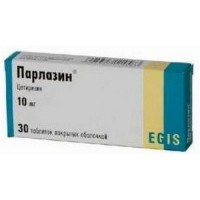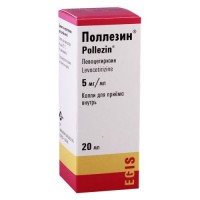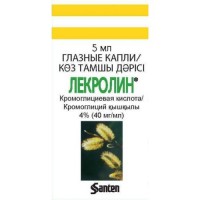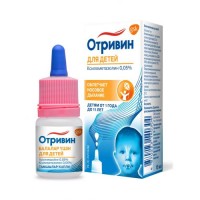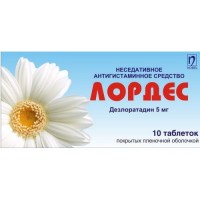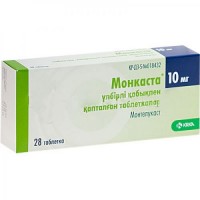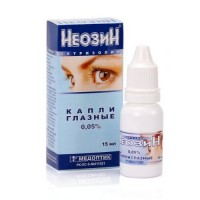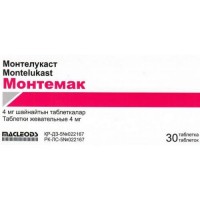Zodak 10 mg / ml 20 ml oral drops
- $18.10
The instruction for medical use of Zodak® medicine the Trade name of Zodak® the International unlicensed name Tsetirizin Lekarstvennaya a form of the Drop, 10 mg/ml, 20 ml Structure of 20 ml of drug contain active agent – a tsetirizin dihydrochloride of 0.200 g, excipients: methylparahydroxybenzoate, propilparagidroksibenzoat, glycerin of 85%, propylene glycol, sodium saccharin, sodium acetate, the ice acetic acid, water purified. Description Transparent, colourless or slightly yellowish solution Pharmacotherapeutic group Antihistaminic drugs of systemic action. Piperazin derivatives. Tsetirizin. The ATX R06AE07 code the Pharmacological Pharmacokinetics Stable Peak Concentration properties of a tsetirizin in blood plasma are about 300 ng/ml and are reached through 1.0 ± 0.5 h. Pharmacokinetic parameters of the maximum concentration in Cmax blood and the area under pharmacokinetic curve AUC have one peak. Meal does not influence extent of absorption, however absorption speed slightly decreases. Degree of bioavailability is similar when using a tsetirizin in the form of solution, capsules or tablets. The seeming volume of distribution is 0.50 l/kg. Linking of a tsetirizin with proteins of blood plasma 93 ± 0.3%. Tsetirizin does not influence linking of warfarin with proteins of plasma. Tsetirizin shows linear kinetics in the range of doses from 5 to 60 mg. Tsetirizin is not exposed to considerable metabolism at the first passing through a liver. Elimination half-life makes about 10 hours. About 2/3 doses are removed in an invariable form with urine. Special groups of patients Elderly: After single dose of 10 mg the elimination half-life increases approximately by 50%, and the clearance decreases by 40%. Decrease in clearance of a tsetirizin at elderly is possibly connected with decrease in function of kidneys at them. Children, children of chest and younger age: Elimination half-life of a tsetirizin makes about 6 hours at children at the age of 6-12 years and 5 hours at children of 2-6 years. At children of chest and younger age of 6-24 months it decreases to 3.1 h. Patients with a renal failure: The pharmacokinetics of drug is similar at patients with small depression of function of kidneys (the clearance of creatinine is higher than 40 ml/min.). At patients with a moderate renal failure the increase in elimination half-life by 3 times and decrease in clearance by 70% takes place. At the patients who are on a hemodialysis (the clearance of creatinine (CC) less than 7 ml/min.) at reception of a single dose of a tsetirizin of 10 mg, increase in elimination half-life by 3 times and decrease in clearance by 70% was noted. Tsetirizin is badly brought at a hemodialysis. Selection of a dose is necessary for patients with moderate and heavy degree of a renal failure. Patients with a liver failure: At the patients with chronic diseases of a liver (pechenochnokletochny, cholestatic and biliary cirrhosis) receiving 10-20 mg of a tsetirizin once the increase in elimination half-life of a tsetirizin for 50% was noted at simultaneous decrease in clearance by 40%. Selection of a dose is necessary for patients with a liver failure who have an accompanying renal failure. The pharmacodynamics of Zodak®, Hydroxyzinum metabolite, is a selection antagonist of peripheral H1 - histamine receptors. In experiments on linking with receptors of in vitro the measured affinity of drug to the receptors different from H1 is not revealed. Except anti-Н1 effect, Zodak® showed antiallergic activity at reception of a dose of 10 mg at reception 1 or 2 times a day: drug inhibits migration of eosinophils in a late phase in skin and in mucous conjunctivas of the persons suffering from an atopy after provocative test with allergen. Researches on healthy volunteers showed what tsetirizin in a dose of 5 mg and 10 mg strongly inhibits the triple answer (skin reaction as blossoming) caused by very high concentrations of a histamine in skin, however communication with efficiency was not revealed. Accustoming cases to antihistaminic action of a tsetirizin during the 35th day course of treatment of children at the age of 5-12 years (suppression of blistering and reddening) were not revealed. Usual reaction of skin to a histamine was restored within 3 days after the termination of the course of treatment meaning repeated introduction of a tsetirizin. During 6 weeks placebo - a controlled research with participation of the patients having allergic rhinitis and slight or moderate asthma, daily reception of 10 mg of a tsetirizin led to improvement of symptoms of rhinitis, without having made negative impact on pulmonary functions. This research showed safety of reception of Zodak® by the patients having at the same time an allergy and asthma of easy or moderate degree. During placebo - a controlled research reception of a tsetirizin in high doses of 60 mg within seven days did not cause significant lengthenings of an interval of QT. In the recommended dose of Zodak® showed improvement of quality of life at patients with year-round and seasonal allergic rhinitis. Indications Stopping of symptoms of allergic diseases at adults and children are more senior than 2 years: - seasonal allergic rhinitis and conjunctivitis (pollinosis, hay fever) - year-round allergic rhinitis and conjunctivitis - a chronic idiopathic small tortoiseshell the Route of administration and doses Children at the age of 2 - 6 years: 2.5 mg twice a day (5 drops two times a day). Children at the age of 6 - 12 years: 5 mg twice a day (10 drops two times a day) Adults and teenagers are more senior than 12 years: 10 mg once in day (20 drops). Elderly patients: older persons have no need of a dose decline on condition of normal function of kidneys. Patients with a moderate or heavy renal failure: the ratios of efficiency/safety of drug given relatively for patients with disturbances of renal function are absent. In case of lack of alternative methods of treatment, it is necessary to change dosing intervals individually, depending on renal function (as the main way of removal of a tsetirizin are kidneys). In the table given below necessary changes of a dose are specified. To use this table, it is necessary to define KK in ml/min. The KK value (ml/min.) can be defined on the basis of creatinine of blood serum (mg/dl) by a formula:
x the weight (kg) of KK = — —— — ——— —— — —— — ——— ——— — (x 0.85 for women) 72 x creatinine of blood serum (mg/dl) of the Dose Zodak® for adult patients with disturbance of renal function: The KK group (ml/min.) the Dosage and frequency of use Normal function ≥ 80 10 mg once a day Easy insufficiency of 50-79 10 mg once a day the Moderated insufficiency of 30-49 5 mg once a day Heavy insufficiency & lt, to 30 5 mg is each 2 days the End-stage of a renal failure – patients on dialysis & lt, 10 Contraindicated Children: at children with a renal failure the dose has to be selected on an individual basis taking into account renal clearance, age and body weight. Patients with a liver failure: from the dose isolated by a liver failure of selection it is not required from patients. Patients with a liver and renal failure: selection of a dose is recommended. The course of treatment is defined by the attending physician. Route of administration: drops are accepted inside, orally – in an undiluted look in a spoon, or dilute with water. In case of use of weak solution, especially at children, it is important to dilute drops with an amount of water, in such quantity which allows the patient to drink off solution (to swallow) for time. Weak solution has to be used immediately. Side effects Clinical trials showed that the recommended doses of Zodak® are capable to cause light side effects of the central nervous system (CNS), including drowsiness, fatigue, dizziness and headaches. It was in certain cases reported about paradoxical stimulation of central nervous system. In spite of the fact that tsetirizin H1 receptors are the selection antagonist peripheral and show rather weak anticholinergic effects, separate cases of problems with urination, disturbances of accommodation of eyes and feeling of dryness in a mouth were registered. Besides, it was reported about cases of deviations of hepatic function with the increased level of content of liver enzymes which were associated with the increased bilirubin level. In most cases these symptoms were eliminated after the termination of administration of drug. Side effects at clinical trials In controlled double blind clinical trials of studying a tsetirizin, placebo or the recommended doses of other antihistaminic drugs (tsetirizin 10 mg a day) were provided quantitative data on safety. Often - fatigue - dizziness, a headache - abdominal pain, dryness in a mouth, nausea - easy drowsiness - pharyngitis Children aged from 6 up to 12 years Often - diarrhea - drowsiness - rhinitis - fatigue Post-marketing observations Besides the side effects registered during clinical trials and which are listed above within post-registration practice the following cases of side effects were recorded. The provided side effects are divided on groups according to terminology of MedDRA and frequency of emergence: very frequent (≥1/10), frequent (from ≥1/100 to & lt, 1/10), infrequent (from ≥1/1000 to & lt, 1/100), rare (from ≥1/10000 to & lt, 1/1000), very rare (& lt, 1/10000), unknown (it is impossible to estimate on the basis of available data): Infrequently - feeling of excitement - paresthesia - diarrhea - the itching, rash - weakness, fatigue Seldom - reactions of hypersensitivity - aggression, confusion of consciousness, a depression, hallucinations, insomnia - spasms - tachycardia - deviations of indicators of function of a liver (the increased content of transaminase, alkaline phosphatase, gamma glutaminetransferase and bilirubin) - a small tortoiseshell - swelled - increase in body weight is Very rare - thrombocytopenia - an acute anaphylaxis - a tic - disturbance of taste (dysgeusia), faints, a tremor, dystonia, dyskinesia - accommodation disturbance, the obscured sight, restriction of the movement of an eyeball - a Quincke's disease, a dieback - a dysuria, enuresis - an asthenia It is unknown - the increased appetite - suicide thoughts - amnesia, memory disturbance - dizziness - a delay of urination of the Contraindication - hypersensitivity to active agent or any of drug excipients, derivatives of Hydroxyzinum or piperazin - patients with a heavy renal failure (clearance of creatinine less than 10 ml/min.) - children aged up to 2 years - pregnancy and the period of a lactation Medicinal interactions Pharmacokinetic researches of interaction of a tsetirizin and pseudoephedrine, antipyrine, Cimetidinum, a ketokonazol, erythromycin, azithromycin of a glipizid, diazepam did not reveal any proofs of adverse pharmakodinamichesky interactions. In several researches of doses of theophylline (400 mg once a day) and a tsetirizina, decrease in clearance of a tsetirizin was observed small (16%) while the arrangement of theophylline was not changed at co-administration of a tsetirizin. At co-administration of a tsetirizin with macroleads (for example, azithromycin, erythromycin) or ketokonazoly did not lead to clinically significant changes of the ECG. At a research of several doses of a ritonavir (600 mg twice a day) and a tsetirizina (10 mg a day) it was revealed that extent of influence of a tsetirizin was increased approximately by 40%, and the arrangement of a ritonavir was slightly changed (-11%) in addition to the accompanying reception of a tsetirizin. Tsetirizin weakens anticoagulating effect of heparin sodium. Azelastin, to alprazola, buprenorphine, a haloperidol, Hydroxyzinum, diazepam, Droperidolum, zolpidy, flurazepam, kvetiapin, Fluphenazin, clozapine, trifluoperazin, thioridazine, phenobarbital, fentanyl, temazepam, risperidon, propofol, remifentanit, promethazine, Perfenazinum, codeine, lorazepam, olanzapine, oxazepam, midazolam, Chlorpromazinum, chlordiazepoxide, to estazola – strengthens (mutually) a deprimation and reduction in the rate of psychomotor reactions. Metohexital, ketamine, izofluran, enfluran in the post-narcotic period - strengthens (mutually) a deprimation and reduction in the rate of psychomotor reactions. Ethanol mutually strengthens a deprimation and reduction in the rate of psychomotor reactions, for the period of treatment it is necessary to refuse alcoholic drinks. Extent of absorption of a tsetirizin does not decrease with meal though the speed of absorption decreases for 1 hour. Tests for a skin allergy are suppressed with antihistamines, their washing away happens within 3 days, it is recommended to pay attention to it before carrying out them. Special instructions In therapeutic doses of clinically significant interactions with alcohol it is not shown (at alcohol level in blood of 0.5 g/l). Nevertheless, at a concomitant use of alcohol it is necessary to be careful. It is necessary to pay special attention to patients who are subject to influence of the factors contributing to an urination delay (for example, damages of a spinal cord, a prostate hyperplasia) as Zodak® can increase risk of a delay of urination. It is recommended to be careful when assigning to patients with epilepsy and risk of developing spasms. Antihistaminic drugs, including and Zodak®, are inhibitors when conducting allergy skin tests therefore before conducting skin tests it is necessary to observe the washing away period (i.e. the period during which medicine is not used, for example, 3 days). Children Reception of Zodak® of a drop for intake is not recommended to babies and children 2 years are younger. Metilparagidroksibenzoat excipients and propilparagidroksibenzoat can cause allergic reactions (perhaps, delayed). The lactation period Tsetirizin is allocated in breast milk in the concentration representing 25% - 90% of those which are available in blood plasma, depending on sampling time after introduction. Therefore it is necessary to stop breastfeeding for treatment. Features of influence of medicine on ability to run the vehicle or potentially dangerous mechanisms At reception of the recommended dose of a tsetirizin of 10 mg were not revealed the evidence of any important clinical effects to ability to run the vehicle, the hidden drowsiness and overall performance on the conveyor. Patients who intend to take the wheel, to participate in potentially dangerous operations or to operate the machine equipment, should not exceed the recommended dose. They should take also into consideration reaction of their organism to a certain drug. Sensitive patients have an administration of drug along with the alcohol or other drugs suppressing activity of central nervous system can cause more noticeable decrease in level of concentration and working capacity. Overdose Symptoms: are connected by the most part with influence on central nervous system or the effects assuming anticholinergic influence. The following symptoms of overdose after reception of a dose at least by 5 times exceeding the recommended daily were observed: confusion of consciousness, diarrhea, dizziness, fatigue, headache, feeling of alarm, expansion of pupils, naggers, feeling of concern, sedation, drowsiness, stupor, tachycardia, tremor and delay of urination. Treatment: Specific antidote is absent. The symptomatic or supporting treatment. With small duration after administration of drug it is necessary to wash out a stomach. The hemodialysis is not effective. A form of release and packing On 20 ml of drug in bottles from dark glass (hydrolytic class III) with a capacity of 25 ml with the screwed cover dropper and a tag of control of the first opening. The bottle together with the instruction for medical use in the state and Russian languages is placed in a pack from cardboard. Storage conditions At a temperature not above 25 °C. To store out of children's reach! 3 years After the first opening contents of a bottle to use a period of storage within 6 months, at storage at a temperature not above 25 °C. Not to apply after an expiration date! Prescription status According to the prescription the Name and the country of the organization - producer Zentiva to. the village, the Czech Republic the Name and the country of the organization - the packer Zentiva to. the village, the Czech Republic the Name and the country the owner of the registration certificate of Sanofi-aventis Kazakhstan LLP, Almaty, Kazakhstan the Name, the address and a contact information (phone, the fax, e-mail) of the organization accepting on t
of a rritoriya of the Republic of Kazakhstan of a claim (offer) on quality of medicines from consumers of Sanofi-aventis Kazakhstan LLP Republic of Kazakhstan, 050013, Almaty, Nazarbayev Ave, 187B phone number: +7 (727) 244-50-96 fax: +7 (727) 258-25-96 e-mail: quality.info@sanofi.com the Name, the address and a contact information (phone, the fax, e-mail) of the organization in the territory of the Republic of Kazakhstan responsible for post-registration observation of safety of medicine of Sanofi-aventis Kazakhstan LLP Republic of Kazakhstan, 050013, Almaty, Nazarbayev Ave, 187B phone number: +7 (727) 244-50-96 fax: +7 (727) 258-25-96 e-mail:
To Develop Kazakhstan.Pharmacovigilance@sanofi.com
x the weight (kg) of KK = — —— — ——— —— — —— — ——— ——— — (x 0.85 for women) 72 x creatinine of blood serum (mg/dl) of the Dose Zodak® for adult patients with disturbance of renal function: The KK group (ml/min.) the Dosage and frequency of use Normal function ≥ 80 10 mg once a day Easy insufficiency of 50-79 10 mg once a day the Moderated insufficiency of 30-49 5 mg once a day Heavy insufficiency & lt, to 30 5 mg is each 2 days the End-stage of a renal failure – patients on dialysis & lt, 10 Contraindicated Children: at children with a renal failure the dose has to be selected on an individual basis taking into account renal clearance, age and body weight. Patients with a liver failure: from the dose isolated by a liver failure of selection it is not required from patients. Patients with a liver and renal failure: selection of a dose is recommended. The course of treatment is defined by the attending physician. Route of administration: drops are accepted inside, orally – in an undiluted look in a spoon, or dilute with water. In case of use of weak solution, especially at children, it is important to dilute drops with an amount of water, in such quantity which allows the patient to drink off solution (to swallow) for time. Weak solution has to be used immediately. Side effects Clinical trials showed that the recommended doses of Zodak® are capable to cause light side effects of the central nervous system (CNS), including drowsiness, fatigue, dizziness and headaches. It was in certain cases reported about paradoxical stimulation of central nervous system. In spite of the fact that tsetirizin H1 receptors are the selection antagonist peripheral and show rather weak anticholinergic effects, separate cases of problems with urination, disturbances of accommodation of eyes and feeling of dryness in a mouth were registered. Besides, it was reported about cases of deviations of hepatic function with the increased level of content of liver enzymes which were associated with the increased bilirubin level. In most cases these symptoms were eliminated after the termination of administration of drug. Side effects at clinical trials In controlled double blind clinical trials of studying a tsetirizin, placebo or the recommended doses of other antihistaminic drugs (tsetirizin 10 mg a day) were provided quantitative data on safety. Often - fatigue - dizziness, a headache - abdominal pain, dryness in a mouth, nausea - easy drowsiness - pharyngitis Children aged from 6 up to 12 years Often - diarrhea - drowsiness - rhinitis - fatigue Post-marketing observations Besides the side effects registered during clinical trials and which are listed above within post-registration practice the following cases of side effects were recorded. The provided side effects are divided on groups according to terminology of MedDRA and frequency of emergence: very frequent (≥1/10), frequent (from ≥1/100 to & lt, 1/10), infrequent (from ≥1/1000 to & lt, 1/100), rare (from ≥1/10000 to & lt, 1/1000), very rare (& lt, 1/10000), unknown (it is impossible to estimate on the basis of available data): Infrequently - feeling of excitement - paresthesia - diarrhea - the itching, rash - weakness, fatigue Seldom - reactions of hypersensitivity - aggression, confusion of consciousness, a depression, hallucinations, insomnia - spasms - tachycardia - deviations of indicators of function of a liver (the increased content of transaminase, alkaline phosphatase, gamma glutaminetransferase and bilirubin) - a small tortoiseshell - swelled - increase in body weight is Very rare - thrombocytopenia - an acute anaphylaxis - a tic - disturbance of taste (dysgeusia), faints, a tremor, dystonia, dyskinesia - accommodation disturbance, the obscured sight, restriction of the movement of an eyeball - a Quincke's disease, a dieback - a dysuria, enuresis - an asthenia It is unknown - the increased appetite - suicide thoughts - amnesia, memory disturbance - dizziness - a delay of urination of the Contraindication - hypersensitivity to active agent or any of drug excipients, derivatives of Hydroxyzinum or piperazin - patients with a heavy renal failure (clearance of creatinine less than 10 ml/min.) - children aged up to 2 years - pregnancy and the period of a lactation Medicinal interactions Pharmacokinetic researches of interaction of a tsetirizin and pseudoephedrine, antipyrine, Cimetidinum, a ketokonazol, erythromycin, azithromycin of a glipizid, diazepam did not reveal any proofs of adverse pharmakodinamichesky interactions. In several researches of doses of theophylline (400 mg once a day) and a tsetirizina, decrease in clearance of a tsetirizin was observed small (16%) while the arrangement of theophylline was not changed at co-administration of a tsetirizin. At co-administration of a tsetirizin with macroleads (for example, azithromycin, erythromycin) or ketokonazoly did not lead to clinically significant changes of the ECG. At a research of several doses of a ritonavir (600 mg twice a day) and a tsetirizina (10 mg a day) it was revealed that extent of influence of a tsetirizin was increased approximately by 40%, and the arrangement of a ritonavir was slightly changed (-11%) in addition to the accompanying reception of a tsetirizin. Tsetirizin weakens anticoagulating effect of heparin sodium. Azelastin, to alprazola, buprenorphine, a haloperidol, Hydroxyzinum, diazepam, Droperidolum, zolpidy, flurazepam, kvetiapin, Fluphenazin, clozapine, trifluoperazin, thioridazine, phenobarbital, fentanyl, temazepam, risperidon, propofol, remifentanit, promethazine, Perfenazinum, codeine, lorazepam, olanzapine, oxazepam, midazolam, Chlorpromazinum, chlordiazepoxide, to estazola – strengthens (mutually) a deprimation and reduction in the rate of psychomotor reactions. Metohexital, ketamine, izofluran, enfluran in the post-narcotic period - strengthens (mutually) a deprimation and reduction in the rate of psychomotor reactions. Ethanol mutually strengthens a deprimation and reduction in the rate of psychomotor reactions, for the period of treatment it is necessary to refuse alcoholic drinks. Extent of absorption of a tsetirizin does not decrease with meal though the speed of absorption decreases for 1 hour. Tests for a skin allergy are suppressed with antihistamines, their washing away happens within 3 days, it is recommended to pay attention to it before carrying out them. Special instructions In therapeutic doses of clinically significant interactions with alcohol it is not shown (at alcohol level in blood of 0.5 g/l). Nevertheless, at a concomitant use of alcohol it is necessary to be careful. It is necessary to pay special attention to patients who are subject to influence of the factors contributing to an urination delay (for example, damages of a spinal cord, a prostate hyperplasia) as Zodak® can increase risk of a delay of urination. It is recommended to be careful when assigning to patients with epilepsy and risk of developing spasms. Antihistaminic drugs, including and Zodak®, are inhibitors when conducting allergy skin tests therefore before conducting skin tests it is necessary to observe the washing away period (i.e. the period during which medicine is not used, for example, 3 days). Children Reception of Zodak® of a drop for intake is not recommended to babies and children 2 years are younger. Metilparagidroksibenzoat excipients and propilparagidroksibenzoat can cause allergic reactions (perhaps, delayed). The lactation period Tsetirizin is allocated in breast milk in the concentration representing 25% - 90% of those which are available in blood plasma, depending on sampling time after introduction. Therefore it is necessary to stop breastfeeding for treatment. Features of influence of medicine on ability to run the vehicle or potentially dangerous mechanisms At reception of the recommended dose of a tsetirizin of 10 mg were not revealed the evidence of any important clinical effects to ability to run the vehicle, the hidden drowsiness and overall performance on the conveyor. Patients who intend to take the wheel, to participate in potentially dangerous operations or to operate the machine equipment, should not exceed the recommended dose. They should take also into consideration reaction of their organism to a certain drug. Sensitive patients have an administration of drug along with the alcohol or other drugs suppressing activity of central nervous system can cause more noticeable decrease in level of concentration and working capacity. Overdose Symptoms: are connected by the most part with influence on central nervous system or the effects assuming anticholinergic influence. The following symptoms of overdose after reception of a dose at least by 5 times exceeding the recommended daily were observed: confusion of consciousness, diarrhea, dizziness, fatigue, headache, feeling of alarm, expansion of pupils, naggers, feeling of concern, sedation, drowsiness, stupor, tachycardia, tremor and delay of urination. Treatment: Specific antidote is absent. The symptomatic or supporting treatment. With small duration after administration of drug it is necessary to wash out a stomach. The hemodialysis is not effective. A form of release and packing On 20 ml of drug in bottles from dark glass (hydrolytic class III) with a capacity of 25 ml with the screwed cover dropper and a tag of control of the first opening. The bottle together with the instruction for medical use in the state and Russian languages is placed in a pack from cardboard. Storage conditions At a temperature not above 25 °C. To store out of children's reach! 3 years After the first opening contents of a bottle to use a period of storage within 6 months, at storage at a temperature not above 25 °C. Not to apply after an expiration date! Prescription status According to the prescription the Name and the country of the organization - producer Zentiva to. the village, the Czech Republic the Name and the country of the organization - the packer Zentiva to. the village, the Czech Republic the Name and the country the owner of the registration certificate of Sanofi-aventis Kazakhstan LLP, Almaty, Kazakhstan the Name, the address and a contact information (phone, the fax, e-mail) of the organization accepting on t
of a rritoriya of the Republic of Kazakhstan of a claim (offer) on quality of medicines from consumers of Sanofi-aventis Kazakhstan LLP Republic of Kazakhstan, 050013, Almaty, Nazarbayev Ave, 187B phone number: +7 (727) 244-50-96 fax: +7 (727) 258-25-96 e-mail: quality.info@sanofi.com the Name, the address and a contact information (phone, the fax, e-mail) of the organization in the territory of the Republic of Kazakhstan responsible for post-registration observation of safety of medicine of Sanofi-aventis Kazakhstan LLP Republic of Kazakhstan, 050013, Almaty, Nazarbayev Ave, 187B phone number: +7 (727) 244-50-96 fax: +7 (727) 258-25-96 e-mail:
To Develop Kazakhstan.Pharmacovigilance@sanofi.com

